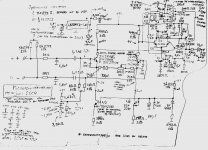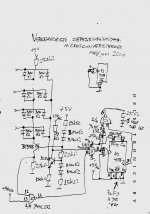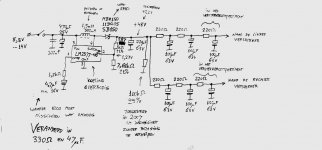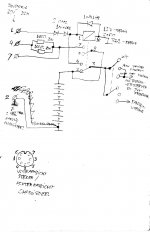I'm in the UK and want to build a simple microphone amp to input to a 2009 Mac Pro computer running Sierra + Garageband to make vocals for home recordings. I have a Sony FV4T mic, typical unidirectional dynamic -60dBv, 600R unbalanced. I could buy a different or better one if required.
I'm open to solid state or tube. If solid state a PCB would make things a lot easier. Ideas for kits welcome - maybe Chinese or off CPC/Farnell etc.
If tube I have plenty of 12AX7 and loads of parts and can easily put a circuit together. What I don't know is how to interface the output with the audio input jack on a Mac computer. Some step-down would be needed, e.g. a transformer or a circuit with an active load e.g. Ale Moglia's Gyrator
Gyrator PCB – Bartola(R) Valves
Can you help me with some ideas and circuits here?
I'm open to solid state or tube. If solid state a PCB would make things a lot easier. Ideas for kits welcome - maybe Chinese or off CPC/Farnell etc.
If tube I have plenty of 12AX7 and loads of parts and can easily put a circuit together. What I don't know is how to interface the output with the audio input jack on a Mac computer. Some step-down would be needed, e.g. a transformer or a circuit with an active load e.g. Ale Moglia's Gyrator
Gyrator PCB – Bartola(R) Valves
Can you help me with some ideas and circuits here?
> how to interface the output with the audio input jack on a Mac computer
Are there any specs for that jack? (I'm not a Mac geek.)
"Stepdown" may not make sense; design for less gain, don't gain-up and throw-away.
While no Mac-guy, I suspect the Mac Line In is lowish-impedance for tubes. If you want to sing, not solder forever, I'd just grab a chip. There is a "$10 mike preamp" which is more than fine for home studio (is used in big-$ consoles).
Mac still has USB? The music shops are full of basic mike-to-USB converters, and most are of very high quality.
Man, that's a hunt for Mac hardware specs.
Mac Pro (2007; but I bet these specs just copy-over)
Analog Audio Specifications
Maximum input voltage: 2 Vrms (+8.2 dBµ)
Input impedance: Greater than 20 kilohms
(I have no idea why Apple used "micro"; would be "u" for "unterminated")
Are there any specs for that jack? (I'm not a Mac geek.)
"Stepdown" may not make sense; design for less gain, don't gain-up and throw-away.
While no Mac-guy, I suspect the Mac Line In is lowish-impedance for tubes. If you want to sing, not solder forever, I'd just grab a chip. There is a "$10 mike preamp" which is more than fine for home studio (is used in big-$ consoles).
Mac still has USB? The music shops are full of basic mike-to-USB converters, and most are of very high quality.
Man, that's a hunt for Mac hardware specs.
Mac Pro (2007; but I bet these specs just copy-over)
Analog Audio Specifications
Maximum input voltage: 2 Vrms (+8.2 dBµ)
Input impedance: Greater than 20 kilohms
(I have no idea why Apple used "micro"; would be "u" for "unterminated")
Very helpful - I couldn't find it! 20K isn't bad. That's within reach of tubes around 2K plate impedence, do you think? Like 6e6p or 6e5p? Don't have any D3A and they're pricey. I like the idea of Ale Moglia's gyrator - active load - and I have some. That would make it possible to use tubes with higher plate impedance. Wondering about cooking up a circuit with a 6N1P for instance.
Apple isn't exactly famous for supporting initiative on the part of their users. You're expected to use what they provide, no more, no less. And to buy a new iThing when the old one fails, not have it repaired ( https://www.cbc.ca/news/thenational...rpricing-restricting-device-repairs-1.4859099 ).I couldn't find it!
Is that 3.5 mm input jack wired the same way every other company wires it? Beware of some bizarre unconventional wiring scheme.
-Gnobuddy
That's one way of using a Firewire audio interface capable of standalone operation, I suppose. Having a preamp like that is a bit like winning the lottery in this case already. Would there be some sort of chance of getting the thing to run properly, i.e. can you get a FW400 card for the 2009 Mac Pro (which seems to be FW 800 only), and if so, would the drivers cooperate with a more modern MacOS? I reckon the ol' Edirol would still be a decently capable interface today, at least about on par with the usual bus-powered USB jobs. That said, I bet the line-in on a 2009 Mac Pro isn't a slouch either (aren't they using an ALC889 or something?).
If you continue using the Edirol as-is, I would suggest the following:
1. Use the XLR input with corresponding balanced mics. Only the XLR in provides full sensitivity and lowest noise, not to mention P48V phantom power for mics that need it (on/off switch on rear panel). With this, the world of studio mics is wide open to you.
You should at least have a large diaphragm condenser mic. As far as inexpensive ones go, I quite like Thomann's t.bone SC 400 (also available as a dual pattern SC 600, cardioid / omni; figure-8 is reserved for higher price brackets). It's basically a generic China LDC (with the usual 34 mm Neumann clone capsule) with a fairly flat on-axis FR and low noise. Give it some acoustic treatment around the rear and a pop filter in addition to the customary mic stand and XLR mic cable, and it should serve you well for recording vocals. The one thing I didn't like was the supplied shock mount, which didn't do much at all here; I ended up bending the handle parts to allow free movement of the insides (previously blocked altogether) and unhooking the elastics in two points, allowing the mic to wiggle back and forth at least (big improvement in shock isolation already).
If you still want a dynamic mic and don't feel like rewiring the ol' FV4T (which looks like nothing special going by data), you can get some rather decent cheap ones. Or just borrow / buy a trusty SM58, I can't imagine there wouldn't be a bunch floating around in London alone.
2. Effective input noise is dependent on input gain (SENS knobs). When using a dynamic mic, they should be at 3-4 o'clock or so, while a typical LDC may only require about 12 o'clock. Match output level to input sensitivity by either MONITOR 1/2 level or headphone level control, depending on which output you are using.
3. You can in principle benefit from balanced signal transmission from the rear outputs when running one of them into the stereo line-in with a balanced TRS cable + 3.5 mm adapter and later subtracting the left channel from the right one or vice versa (never having used GarageBand, I have no idea whether there is an easy way to accomplish that). This may, however, not even be necessary in this scenario, and the headphone output may do the business just fine.
If you continue using the Edirol as-is, I would suggest the following:
1. Use the XLR input with corresponding balanced mics. Only the XLR in provides full sensitivity and lowest noise, not to mention P48V phantom power for mics that need it (on/off switch on rear panel). With this, the world of studio mics is wide open to you.
You should at least have a large diaphragm condenser mic. As far as inexpensive ones go, I quite like Thomann's t.bone SC 400 (also available as a dual pattern SC 600, cardioid / omni; figure-8 is reserved for higher price brackets). It's basically a generic China LDC (with the usual 34 mm Neumann clone capsule) with a fairly flat on-axis FR and low noise. Give it some acoustic treatment around the rear and a pop filter in addition to the customary mic stand and XLR mic cable, and it should serve you well for recording vocals. The one thing I didn't like was the supplied shock mount, which didn't do much at all here; I ended up bending the handle parts to allow free movement of the insides (previously blocked altogether) and unhooking the elastics in two points, allowing the mic to wiggle back and forth at least (big improvement in shock isolation already).
If you still want a dynamic mic and don't feel like rewiring the ol' FV4T (which looks like nothing special going by data), you can get some rather decent cheap ones. Or just borrow / buy a trusty SM58, I can't imagine there wouldn't be a bunch floating around in London alone.
2. Effective input noise is dependent on input gain (SENS knobs). When using a dynamic mic, they should be at 3-4 o'clock or so, while a typical LDC may only require about 12 o'clock. Match output level to input sensitivity by either MONITOR 1/2 level or headphone level control, depending on which output you are using.
3. You can in principle benefit from balanced signal transmission from the rear outputs when running one of them into the stereo line-in with a balanced TRS cable + 3.5 mm adapter and later subtracting the left channel from the right one or vice versa (never having used GarageBand, I have no idea whether there is an easy way to accomplish that). This may, however, not even be necessary in this scenario, and the headphone output may do the business just fine.
Very helpful - I've noted your comments. I have my eye on a Rode NT-2A for use with the Edirol in the first instance. That should work.
But in the long term I'm really interested in building a preamp - I've built several in the past for my sound system using DHTs. For more gain, though, I'll be looking at an IDHT. What I want to know is how to convert an analogue output to digital. There must be some kind of PCB available. I know nothing about building with digital but I can build a circuit.
Can anyone recommend an AD circuit of any kind, or maybe a budget ready-made?
But in the long term I'm really interested in building a preamp - I've built several in the past for my sound system using DHTs. For more gain, though, I'll be looking at an IDHT. What I want to know is how to convert an analogue output to digital. There must be some kind of PCB available. I know nothing about building with digital but I can build a circuit.
Can anyone recommend an AD circuit of any kind, or maybe a budget ready-made?
> recommend an AD circuit of any kind, or maybe a budget ready-made?
For *audio* quality: it's called a "sound card", buy it pre-made, DIY makes little sense. From the $20 USB dongles to the $2,000 "interfaces" there is not $1,980 of difference.
If you must put a tube in front, you only need Line In (which is good; cheap mike-amps can be funky).
Note the silliness of a 200+V tube to deliver a <2V signal.
Solo singer/player can do tracking with a simple stereo job.
I have been "burned" by this advice. Around 1995 I got the cheapest USB sound-dongle I had yet seen. After some oddities in my analysis, I noticed it was not really "16 bit" but 15 bit!! The top bit was stuck "off". Since I am sure the chip's top bit worked, this musta been some fluke goof in the implementation. And I actually got a lot of work done on that thing (90dB DR is not that bad).
For *audio* quality: it's called a "sound card", buy it pre-made, DIY makes little sense. From the $20 USB dongles to the $2,000 "interfaces" there is not $1,980 of difference.
If you must put a tube in front, you only need Line In (which is good; cheap mike-amps can be funky).
Note the silliness of a 200+V tube to deliver a <2V signal.
Solo singer/player can do tracking with a simple stereo job.
I have been "burned" by this advice. Around 1995 I got the cheapest USB sound-dongle I had yet seen. After some oddities in my analysis, I noticed it was not really "16 bit" but 15 bit!! The top bit was stuck "off". Since I am sure the chip's top bit worked, this musta been some fluke goof in the implementation. And I actually got a lot of work done on that thing (90dB DR is not that bad).
Last edited:
Note that not everyone is entirely fond of the highs peak present in the NT-1A (and I think the 2A as well, which is the multipattern version). I personally prefer the NT-1's sound, at least from what I've heard. The NT-1A is probably the cheapest super-duper-quiet mic, of course. (They're using the very same Chinese capsules, just with internal shock mounting and very low-noise electronics.) From personal experience, I find the SC-400's ca. 18 dB(A) noise floor entirely sufficient for the amateur, however, or at least getting my room (not a studio) sufficiently quiet to make full use of it proved to be quite a challenge. That said, another mic with ca. 23 dB(A) (once a typical value way back in the early 2000s when inexpensive LDCs first appeared) did still leave some room for improvement.Very helpful - I've noted your comments. I have my eye on a Rode NT-2A for use with the Edirol in the first instance. That should work.
Tube mic preamps are not a trivial exercise if you want to get actually good performance out of them. The legendary IRT V76 module uses a 1:30 input transformer, 9:1 output transformer (neither of which see appreciable DC current to keep size down) and no less than 3 plate chokes for its 4 low-noise pentode stages.But in the long term I'm really interested in building a preamp - I've built several in the past for my sound system using DHTs. For more gain, though, I'll be looking at an IDHT.
It may be easier to build sort of a line-level effects device.
Depends on how you want your bits and bytes. I2S? SPDIF? USB? AES/EBU? Also, more than 2 channels perhaps?What I want to know is how to convert an analogue output to digital. There must be some kind of PCB available. I know nothing about building with digital but I can build a circuit.
Can anyone recommend an AD circuit of any kind, or maybe a budget ready-made?
This one is rather nice:
AD24QS - Audio Analog to Digital Converter 24 Bit / 192 kHz
Not sure whether it meets your definition of "budget", of course.
Dynamic range is about on par with an old Asus Xonar D1 (DX), or D2 (D2X) for the "flagship ADC" version, which is not entirely coincidental as they are using the same ADC chips. (I've picked up D1s for around or little more than 20€ if memory serves. Mind you, they are old PCI soundcards, with Windows drivers that are quirky to say the least, and no MacOS drivers at all. I've also seen defective DX cards being sold in lots, apparently they like to fail semi-regularly for some reason - might be worth picking up for parts alone, now that I think about it. Just checked, and CS5361s or CS4398s in low quantities are about 10€ a pop at Mouser or £9+ at RS Components, yikes.)
Last edited:
See the attachments for the battery-powered microphone amplifier with phantom supply that I've used since 2004, both for live recording a choir and for live recording bird sounds, among other things. The phantom supply is of course not needed for dynamic microphones. Mind you, the maximum output level is only about 1 V RMS and some of the transistors are out of production, but there are usually good SMD replacements available.
Attachments
Indeed. Be very clear about why you want a tube pre-amp.Tube mic preamps are not a trivial exercise ...
It may be easier to build sort of a line-level effects device.
Everything Russel Hamm said in 1973 remains true, if not more so (as clipping your ADC is the worst sort of ugly short of feeding an illegal sequence into your DAC).
Mintz, in his rebuttal, became perhaps the first person to try and emulate a simple valve circuit with a complex transistor one. (See the wikipedia entry on soft clipping)
I've just built a little progressive clipper, which, so far, seems to do what it should (softening a fizzy solid state guitar amp clipping stage). (No FFTs yet!). It is based on the late Fred Nachbaur's dogzilla, but with different diode chains to get initially asymmetric clipping (final clipping is symmetric to avoid DC drift).
Hamm 1973 21(4) JAES "Tubes vs Transistors - Is There An Audible Difference?" (pdf here)
Last edited:
Update - I have bought a used Rode TN-2A which works fine in terms of volume with my Edirol FA-101 using the Firewire output. So I have a working setup at last. The sound is super clean, as you would expect from this combination. I have yet to learn how to treat the mic input in Garageband with reverb, equalisation etc. and this may help make the sound less dry and clean. But I'm now wondering what else I can do to "personalise" the sound a bit. I don't want to use a tube microphone - don't see the point - but I'm curious about a transformer mic. I could build one of those, and I like what I've heard of Oktava plus a U87 clone would be nice. And then I'm so used to tube technology that building a tube input stage wouldn't be difficult. Initially it could feed the line in on my Mac. I have yet to try the Edirol into the line in - must see what the difference in sound is.
I'll start looking at simple tube circuits that can be used. For instance a phono stage without the equalisation should work, no? I'm sure there are plenty of other designs I could use. Any suggestions?
I'll start looking at simple tube circuits that can be used. For instance a phono stage without the equalisation should work, no? I'm sure there are plenty of other designs I could use. Any suggestions?
It would work, and if built competently it won't sound any different to your existing set up. That is, hyper clean.I'll start looking at simple tube circuits that can be used. For instance a phono stage without the equalisation should work, no?
I.E. it won't do what you want it to do, which is to impart some "flavour".
Any audible difference will come from what you (currently) consider to be a flawed design or implementation: devices biased in incorrect ways (e.g. cold clipper for early onset of 2nd harmonic ) or being overdriven (classic transformer/tape head "sound")
It would work, and if built competently it won't sound any different to your existing set up. That is, hyper clean.
I.E. it won't do what you want it to do, which is to impart some "flavour".
That's not exactly how I see it, though I agree that if the basics are covered like frequency response and noise performance you might get substantially the same results. In my audio setup I build with directly heated triodes for a reason - I get more "inner transparency" within the sound of the voices and instruments and the timbre is closer to the original acoustic instruments which I am familiar with from being a pro musician. For instance with microphones there's more "inner transparency" in a Neumann U87 than in the TLM series. What I'm seeking to avoid is graininess (a hard sound) and "thickness" described variously as "dull", "veiled" etc. I achieve this with DHTs and very simple circuits with a minimum of components (though elaborate power supplies) and no global feedback.
I don't know how the above applies to very small signals - I sold my LPs years ago and haven't built a phono stage for at least 15 years, probably more. In theory I like the sound of ribbons and transformers, though I'm not convinced in the case of microphones, though I have heard some good sound samples. This is completely new territory for me - microphones.
It could be the case, also, that I want some sort of "flavour" which is a different thing from the transparency I seek in my audio setup. Something that would flatter my voice, which could be all kinds of added equalisation, reverb etc. Early days yet. I need to talk to a studio engineer about recording vocals - that should be educational and would save time over simple trial and error.
You've correctly corrected me: a well built DHT system should have much better low level performance than anything else on the planet (for the doubters, the 45 triode is still the most linear device ever made and the poor supply rail noise rejection of a DHT SET amp means that the power supply has to be good - ergo: none of the sagging and 120hz intermodulation of AB designs).That's not exactly how I see it, though I agree that if the basics are covered like frequency response and noise performance you might get substantially the same results. In my audio setup I build with directly heated triodes for a reason - I get more "inner transparency" within the sound of the voices and instruments and the timbre is closer to the original acoustic instruments which I am familiar with from being a pro musician.
Plus several.It could be the case, also, that I want some sort of "flavour" which is a different thing from the transparency I seek in my audio setup. ..... Early days yet. I need to talk to a studio engineer about recording vocals - that should be educational and would save time over simple trial and error.
Last edited:
- Status
- This old topic is closed. If you want to reopen this topic, contact a moderator using the "Report Post" button.
- Home
- Live Sound
- Instruments and Amps
- Basic DIY microphone amp, tube or SS



